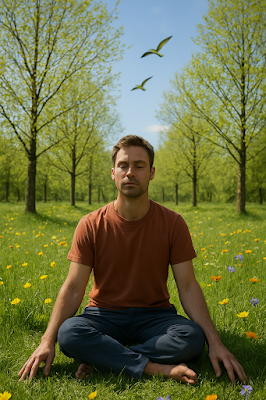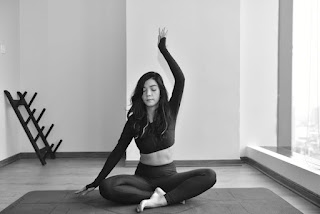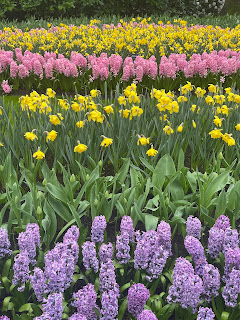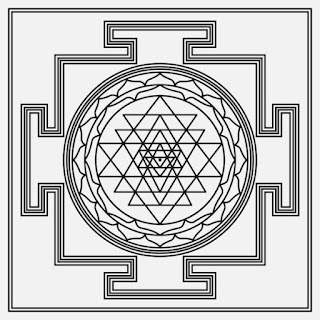Unplugging to Reconnect: Using Yoga and Meditation for Digital Detox
In an era where our lives are increasingly intertwined with digital devices, finding moments of genuine peace and connection can feel like a distant dream. The buzzing notifications, endless scrolling, and the pressure to stay “on” round the clock have left many of us feeling more disconnected from ourselves than ever before. It’s crucial, now more than ever, to carve out spaces of tranquility and to reconnect with the essence of our well-being. Enter the transformative practices of yoga and meditation – timeless tools that have gained new relevance in our digital age.
Yoga, with its harmonious blend of physical postures, breathing techniques, and meditation, offers a refuge from the digital chatter, guiding us back to our bodies and breath. It’s not just about physical flexibility but about fostering mental resilience, allowing us to navigate the digital world with a sense of balance and groundedness. Meanwhile, meditation opens the door to mindfulness, teaching us to observe our thoughts and digital habits without judgment, and ultimately, to cultivate a more intentional relationship with technology.
For those seeking a digital detox, these practices are not a mere escape but a return to what’s real and tangible – our breath, our senses, and our capacity for inner peace. They remind us that in a world where being constantly connected is the norm, disconnecting is not just an act of rebellion; it’s an act of self-care.
As we delve into the heart of this guide, we explore not just the why but the how of using yoga and meditation to detox from the digital world. From practical tips to personal insights, this journey is about rekindling a connection with ourselves that transcends the digital noise. It’s about finding balance in an unbalanced world and discovering that sometimes, the best way to recharge is by unplugging.

Recognizing the Need for Digital Detox
In a world saturated with digital interactions, the call for a digital detox has never been more urgent. The constant barrage of notifications, emails, and the endless scroll through social media can lead to a profound sense of disconnection — from our surroundings, our loved ones, and, most importantly, ourselves. For those seeking to reclaim a sense of presence and peace, understanding the necessity of stepping back from the digital realm is the first step towards nurturing a healthier relationship with technology.
The digital age, while bringing unparalleled convenience into our lives, also ushers in a host of challenges. Eye strain, disrupted sleep patterns, and a decrease in physical activity are just the tip of the iceberg. Below the surface lies a more insidious effect: the impact on our mental well-being. Studies have shown that excessive digital consumption can exacerbate feelings of loneliness, anxiety, and depression. It skews our perception of time, making hours seem like minutes, and often leaves us feeling unfulfilled and restless.

This is where the transformative power of yoga and meditation comes into play. Yoga, a practice that dates back thousands of years, offers a holistic approach to well-being. It’s not merely a form of physical exercise but a discipline that integrates body, mind, and spirit. Through yoga, one can achieve a state of calm and clarity, counteracting the overstimulation brought about by digital devices. It encourages mindfulness, a quality that becomes a guiding light in navigating the digital landscape more consciously.
Meditation complements this journey by fostering an inner sanctuary of peace, away from the cacophony of the digital world. It teaches us to be observers of our thoughts and emotions, without getting entangled in them. This skill is invaluable in managing digital consumption, helping us to discern when our use of technology serves us and when it hinders our well-being.
Incorporating these practices into daily life doesn’t require drastic changes. It begins with small, intentional actions — setting boundaries around screen time, practicing mindfulness exercises during breaks, or engaging in a few minutes of yoga each morning. These acts of self-care become the foundation upon which a more balanced and fulfilling life can be built, free from the shackles of digital overload.
As we continue to navigate through the digital era, the wisdom of yoga and meditation offers a beacon of light. It reminds us that in the quest for connectivity, the most profound connection we can cultivate is the one with ourselves.

Yoga for Stress Relief and Physical Wellness
The transformative power of yoga extends beyond its ability to quiet the mind; it is a potent remedy for stress and a gateway to enhanced physical wellness. At its core, yoga is about establishing a harmonious balance between strength and flexibility, a balance that becomes particularly significant as we navigate the complexities of life.
Yoga’s holistic approach encompasses various styles and practices, each offering unique benefits. For those seeking to alleviate stress, practices like Hatha Yoga and Restorative Yoga focus on gentle movements and deep relaxation, making them ideal for unwinding after a long day consumed by digital interactions. These styles prioritize slow-paced postures, deep breathing, and mindfulness, encouraging a state of calm and presence.
Physical wellness, particularly as we mature, requires attention to flexibility, balance, and muscle tone — aspects that yoga addresses with grace. The beauty of yoga lies in its adaptability; it can be modified to suit different levels of fitness and mobility, making it accessible to everyone. Poses such as the Warrior series strengthen the body, while balance poses like Tree Pose improve stability, and stretches like the Seated Forward Bend enhance flexibility.

Incorporating yoga into one’s routine doesn’t necessitate hours of practice each day. Even a few minutes can make a significant difference in how we feel physically and mentally. It can be as simple as starting with a ten-minute morning session focused on a series of gentle poses or ending the day with a mindfulness-based meditation to promote restful sleep. The key is consistency and listening to one’s body, making adjustments as needed to accommodate personal comfort and goals.
The integration of yoga into daily life serves as a potent antidote to the stress induced by our digital habits. It offers a pathway to not just manage stress, but to embrace a lifestyle that prioritizes wellness and vitality. As we step onto the yoga mat, we step away from the digital noise, reconnecting with our bodies, our breath, and our capacity for inner peace.
In the following section, we’ll explore the complementary role of meditation in enhancing this journey towards digital detox and overall well-being.

Meditation and Mindfulness: Reconnecting with Yourself in the Digital Age
In the digital age, where our senses are constantly bombarded by a flurry of notifications, emails, and messages, the art of meditation emerges as a sanctuary for the soul. Meditation, often perceived as the quiet cousin of the more physically engaging yoga, holds the key to unlocking profound levels of self-awareness and mindfulness. It invites us to pause, breathe, and truly listen to the whispers of our inner self amidst the cacophony of the digital world.
Mindfulness meditation, in particular, offers a practical approach to cultivating a moment-to-moment awareness of our thoughts, feelings, and sensations without judgment. This practice encourages us to observe our digital habits and their impact on our well-being with compassion and curiosity. By becoming mindful of how we interact with technology, we empower ourselves to make intentional choices, fostering a healthier digital life balance.
The benefits of meditation extend far beyond mere stress reduction. Regular practice enhances focus, reduces anxiety, and improves emotional resilience. For individuals navigating the complexities of life, these benefits are invaluable. Meditation teaches us to respond to challenges with a sense of calm and clarity, qualities that are often overshadowed by the fast-paced digital world.

Integrating meditation into daily life is simpler than it might seem. It can start with dedicating just a few minutes each day to sit in silence, focusing on the breath or a mantra. There’s no need for special equipment or a perfect setting; it’s the intention and consistency that count. Over time, these brief moments of stillness can transform into a profound source of peace and rejuvenation.
As we continue on this journey of digital detox, incorporating meditation alongside yoga offers a holistic path to reclaiming our time and attention. Together, they provide a foundation for a more mindful, balanced, and connected life, free from the constraints of digital overload.
In the next segment, we will explore the importance of strengthening the mind-body connection to further enhance our well-being in the digital era.

Strengthening the Mind-Body Connection to Combat Digital Overload
In our journey through digital detox, acknowledging and nurturing the mind-body connection becomes a cornerstone for achieving lasting well-being. This ancient concept, deeply rooted in the practices of yoga and meditation, teaches us that the mind and body are not separate entities but interconnected aspects of our being. By strengthening this connection, we arm ourselves against the adverse effects of digital overload, enhancing our ability to navigate the complexities of the modern world with resilience and grace.
The mind-body connection is at the heart of yoga’s philosophy. Each posture, or asana, is not just a physical exercise but a mindful practice, bridging the gap between body awareness and mental clarity. This symbiosis encourages a deeper understanding of our physical limitations and strengths, fostering a kinder and more compassionate relationship with ourselves. As we become more attuned to our bodies, we also learn to recognize the signs of digital fatigue — eye strain, tension headaches, or mental fog — prompting us to take necessary breaks and engage in restorative practices.
Similarly, meditation deepens the mind-body connection by drawing our attention inward, away from external distractions. Through focused breathing and mindful observation, we cultivate an awareness that illuminates the interconnectedness of our thoughts, emotions, and physical sensations. This awareness enables us to discern the subtle ways in which digital consumption affects our well-being, empowering us to make more mindful choices about how we interact with technology.
The benefits of strengthening the mind-body connection extend beyond combating digital overload. It enhances overall well-being, improves emotional regulation, and promotes a sense of inner peace. Moreover, it fosters a holistic approach to health, recognizing that physical ailments can have emotional roots and vice versa.
Integrating simple practices into daily life can significantly bolster the mind-body connection. Whether it’s performing a few yoga poses upon waking, taking mindful breaths during work breaks, or practicing meditation before bed, each act of mindfulness contributes to a stronger, more resilient self.
As we move forward, remember that the journey towards digital detox and enhanced well-being is a personal one. By listening to our bodies and minds, we navigate this path with intention, embracing the tools of yoga and meditation not just as practices but as guides to a more balanced, connected life in the digital age.
Creating a Balanced Lifestyle: Practical Tips
In a world where digital devices are integral to our daily lives, finding a balance between online and offline worlds is crucial. This balance is especially pertinent as we navigate through different phases of life, seeking ways to maintain wellness, connection, and inner peace. Here are practical tips to help foster a lifestyle that harmonizes the benefits of the digital world with the grounding presence of the real world:
- Establish Digital Boundaries: Designate specific times of the day as tech-free zones. Whether it’s during meals, one hour before bed, or the first hour after waking up, these moments can significantly enhance your quality of life and relationships.
- Mindful Technology Use: Be intentional with how you use technology. Ask yourself whether it adds value or serves a specific purpose. This mindfulness can reduce unnecessary screen time and foster more meaningful digital interactions.
- Digital Detox Rituals: Incorporate regular digital detoxes into your routine. This could be a day each week or a weekend each month where you significantly reduce or eliminate digital device usage, allowing yourself time to reconnect with the world around you.
- Connect with Nature: Spend time outdoors every day. Nature has a profound ability to soothe the mind and body, offering a perfect counterbalance to the digital world’s hustle and bustle.
- Pursue Offline Hobbies: Engage in hobbies that don’t require a screen. Reading, gardening, crafting, or journaling are wonderful ways to spend your leisure time and stimulate creativity without digital interference.
- Yoga and Meditation Practice: Incorporate yoga and meditation into your daily routine. Even a few minutes can have a significant impact, helping to strengthen the mind-body connection and foster inner peace.
- Cultivate Real-World Connections: Prioritize face-to-face interactions with friends and family. These connections are invaluable and offer a depth of interaction that digital communication can’t replicate.
By integrating these practices into your life, you create a robust foundation for a balanced and fulfilling existence, one that embraces the best of both digital and natural worlds.





